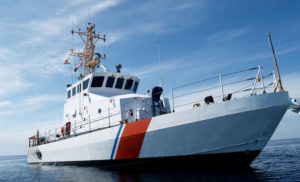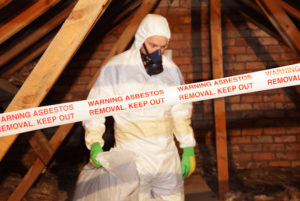Mesothelioma Risk for U.S. Coast Guard Veterans
The U.S. Coast Guard keeps America’s borders safe, protecting waterways for centuries and saving countless lives in the process. The many duties of the U.S. Coast Guard put its members at risk every day.
 However, thousands who served in the U.S. Coast Guard may have been put in unseen danger. This is because asbestos was once commonly used by the U.S. Coast Guard because it was cheap and very powerful.
However, thousands who served in the U.S. Coast Guard may have been put in unseen danger. This is because asbestos was once commonly used by the U.S. Coast Guard because it was cheap and very powerful.
From the 1930s to the early 1980s, asbestos could be found in:
- Ships
- Aircraft
- Bases
Asbestos is fireproof and a powerful insulator. It also resists electricity and water. However, asbestos was actually very dangerous, and those exposed could develop mesothelioma or other diseases later in life.
Fortunately, U.S. Coast Guard veterans can receive benefits through the U.S. Department of Veterans Affairs (VA) and mesothelioma legal claims. One of the easiest ways to file these claims is through a mesothelioma law firm.
Billions Recovered Nationwide
At Sokolove Law, we’ve recovered over $5.2 Billion for thousands of mesothelioma patients and their families nationwide. Let us get you the results you deserve.
U.S. Coast Guard Veterans & Asbestos Dangers
As U.S. Coast Guard assets like ships and bases were built and used, asbestos fibers were released into the surrounding air. When inhaled or swallowed, these fibers could get stuck in their bodies and eventually cause mesothelioma and other asbestos-related diseases.
It takes 20-50 years for mesothelioma to develop, so many former U.S. Coast Guard service members are being diagnosed long after they served.
Once the disease develops, it is very aggressive and almost always fatal. However, emerging treatments show promise for helping patients live longer.
How Were U.S. Coast Guard Veterans Exposed to Asbestos?
U.S. Coast Guard personnel were exposed to asbestos through numerous military assets. As U.S. Coast Guard personnel worked and served, they may have been exposed to asbestos from many different products.
Common asbestos-containing products included:
- Boilers
- Ceiling and floor tiles
- Electrical wiring
- Gaskets
- Heat-resistant gloves and clothing
- Insulation
- Motor systems
- Pipes
- Ship doors
Call Sokolove Law right now at (800) 647-3434 if you've been diagnosed with mesothelioma or another asbestos-related disease.
List of U.S. Coast Guard Cutters with Asbestos
Asbestos was used on the following list of U.S. Coast Guard cutters.
- USCGC Absecon (WHEC-374)
- USCGC Active (WMEC-618)
- USCGC Acushnet (WMEC-167)
- USCGC Alert (WMEC-630)
- USCGC Androscoggin (WHEC-68)
- USCGC Barataria (WHEC-381)
- USCGC Bering Strait (WHEC-382)
- USCGC Bibb (WPG-31)
- USCGC Boutwell (WHEC-719)
- USCGC Campbell (WPG-32)
- USCGC Casco (WHEC-370)
- USCGC Castle Rock (WHEC-383)
- USCGC Chase (WHEC-718)
- USCGC Chautauqua (WHEC-41)
- USCGC Chincoteague (WHEC-375)
- USCGC Confidence (WMEC-619)
- USCGC Cook Inlet (WHEC-384)
- USCGC Coos Bay (WHEC-376)
- USCGC Courageous (WMEC-622)
- USCGC Dallas (WHEC-716)
- USCGC Dauntless (WMEC-624)
- USCGC Decisive (WMEC-629)
- USCGC Dependable (WMEC-626)
- USCGC Dexter (WHEC-385)
- USCGC Diligence (WMEC-616)
- USCGC Duane (WPG-33)
- USCGC Durable (WMEC-628)
- USCGC Escanaba (WHEC-64)
- USCGC Escape (WMEC-6)
- USCGC Gallatin (WHEC-721)
- USCGC Gresham (WHEC-387)
- USCGC Haida (WPG-45)
- USCGC Half Moon (WHEC-378)
- USCGC Hamilton (WHEC-715)
- USCGC Hamilton (WPG-34)
- USCGC Humboldt (WHEC-372)
- USCGC Ingham (WPG-35)
- USCGC Iroquois (WHEC-43)
- USCGC Jarvis (WHEC-725)
- USCGC Klamath (WHEC-66)
- USCGC Mackinac (WHEC-373)
- USCGC Matagora (WHEC-371)
- USCGC McCulloch (WHEC-386)
- USCGC Mellon (WHEC-717)
- USCGC Mendota (WHEC-69)
- USCGC Midgett (WHEC-726)
- USCGC Minnetonka (WHEC-67)
- USCGC Modoc (WPG-46)
- USCGC Mojave (WPG-47)
- USCGC Morgenthau (WHEC-70)
- USCGC Munro (WHEC-724)
- USCGC Owasco (WHEC-39)
- USCGC Pontchartrain (WHEC-70)
- USCGC Reliance (WMEC-615)
- USCGC Resolute (WMEC-620)
- USCGC Rockaway (WHEC-377)
- USCGC Rush (WHEC-723)
- USCGC Sebago (WHEC-42)
- USCGC Sherman (WHEC-720)
- USCGC Spencer (WPG-36)
- USCGC Steadfast (WMEC-623)
- USCGC Tampa (WPG-48)
- USCGC Taney (WPG-37)
- USCGC Unimak (WHEC-379)
- USCGC Valiant (WMEC-621)
- USCGC Venturous (WMEC-625)
- USCGC Vigilant (WMEC-617)
- USCGC Vigorous (WMEC-627)
- USCGC Wachusett (WHEC-44)
- USCGC Winnebago (WHEC-40)
- USCGC Winona (WHEC-65)
- USCGC Yakutat (WHEC-380)
- USCGC Yocona
If you were on any of these cutters and later received an asbestos-related disease diagnosis, you may be eligible for compensation that we can fight for on your behalf. See if you qualify now for free.
U.S. Coast Guard Jobs at Risk of Asbestos Exposure
For much of the 20th century, almost everyone in the U.S. Coast Guard was exposed in some way to asbestos materials. However, certain military personnel ran a higher risk of exposure.
Those who ran the highest risk included:
Construction Workers
U.S. Coast Guard bases, barracks, and offices frequently used asbestos in the walls, roofs, and flooring. This helped with fireproofing and keeping bases resistant to water damage.

Though everyone who spent time in these buildings was potentially at risk, the U.S. Coast Guard members who built them were in especially high danger. U.S. Coast Guard construction workers came in contact with asbestos-based insulation, cement, and paint.
If they had to demolish or repair asbestos-based buildings, asbestos fibers could be released into the surrounding air. This would not only endanger them but other nearby U.S. Coast Guard personnel.
Mechanics
The U.S. Coast Guard frequently uses helicopters to intercept potential air threats and perform rescues at sea. They may also use other aircraft for various missions. Helicopters and other aircraft were often built with parts containing asbestos before the material was linked to deadly diseases.
Helicopter engines, brakes, and rotary wings used asbestos-based materials to keep them working longer. When U.S. Coast Guard mechanics would repair or replace these parts, they put themselves at direct risk of asbestos exposure.
Ship Personnel
Much like the U.S. Navy ships, U.S. Coast Guard vessels once contained a huge assortment of asbestos products.
Asbestos was present almost everywhere in these ships, including wall insulation, engine rooms, boiler rooms, and in much of their equipment.
Long-term exposure to asbestos often occurred in U.S. Coast Guard cutters. The term “cutter” refers to ships that are part of the Coast Guard’s active fleet. They are designed to have a full crew live on board for lengthy missions.
Cutters that were used in the mid-20th century were built with massive amounts of asbestos. They were often cramped and had poor ventilation, increasing the likelihood of exposure.
As asbestos-based products aged aboard these ships, they were more likely to break down and release fibers into the air.
Throughout the mid-1980s, the government ordered asbestos-containing materials to be removed from ships and other assets to protect those who serve. However, thousands of U.S. Coast Guard personnel had already been exposed.
Shipyard Workers
U.S. Coast Guard workers who built or worked on ships ran the highest risk of asbestos exposure. Shipbuilding essentially combined the risks of serving on a ship with that of mechanical work.
U.S. Coast Guard shipyard workers had to build, install, or repair equipment that could be lethal to those who served on the ship. Even shipyard workers who performed general maintenance had a higher risk of asbestos exposure.
Thankfully, mesothelioma VA benefits and financial compensation are available to qualifying U.S. Coast Guard shipyard workers and other veterans. Learn more by calling (800) 647-3434.
Help for U.S. Coast Guard Veterans With Mesothelioma
Since the U.S. Coast Guard is not as large as the U.S. Army, U.S. Navy, or U.S. Air Force, there are fewer reported cases of mesothelioma from this military branch. However, that does not mean U.S. Coast Guard veterans are at a decreased risk.
Sadly, thousands of military veterans have been diagnosed with mesothelioma, an asbestos-caused disease. Mesothelioma has no cure, and without treatment, it can be lethal in months.
If you or a loved one served in the U.S. Coast Guard and was diagnosed with mesothelioma, treatments can possibly extend your life. However, these treatment options can be expensive. A mesothelioma law firm can help you afford them.
Sokolove Law: Fighting on Behalf of Veterans Nationwide

Sokolove Law has over 45 years of experience in handling legal claims and has recovered over $5.2 Billion for mesothelioma victims and their families.
We can also help you pursue monthly financial aid through the VA. Depending on your VA claim, you could qualify for pension plans, health insurance, survivor benefits, and many other helpful services.
Sokolove Law has VA-accredited attorneys on staff who can help secure these VA benefits. Our mesothelioma lawyers can also help you pursue legal claims against asbestos-related companies. This legal action can help you earn even more financial compensation through a lawsuit or asbestos trust fund.
You will not sue the U.S. Coast Guard or federal government, but your suit may include the companies that sold asbestos-containing products to them without warning of the dangers.
Get started today with a free case review by calling (800) 647-3434 or filling out our contact form.
Mesothelioma & U.S. Coast Guard Veterans FAQs
How were U.S. Coast Guard veterans put at risk of asbestos exposure?
Any U.S. Coast Guard veteran that served between the 1930s and early 1980s — when asbestos was widely used by the military — could have been exposed.
That said, U.S. Coast Guard personnel were commonly put at risk if they worked with or around asbestos-containing materials.
U.S. Coast Guard veterans who served as mechanics, shipyard workers, and construction workers were all at a high risk of asbestos exposure.
How many U.S. Coast Guard cutters used asbestos?
Hundreds of U.S. Coast Guard cutters may have used asbestos-containing products. The U.S. Coast Guard and the U.S. Navy both used many asbestos-based products aboard their ships.
Asbestos was thought to be a highly durable and safe material to use aboard ships and other military assets, but it’s now known to cause mesothelioma and other life-threatening diseases.
Can U.S. Coast Guard veterans with mesothelioma receive VA benefits?
Possible, yes. The VA considers mesothelioma and other asbestos-related diseases to be disabilities caused by military service if asbestos exposure occurred during your time in the U.S. Coast Guard.
According to the U.S. Department of Veterans Affairs, veterans with mesothelioma are eligible to receive over $3,800+ a month through a VA mesothelioma claim.
To access these benefits, you will need to file a VA benefits claim. When you work with Sokolove Law, our VA-accredited attorneys can help with this process.
